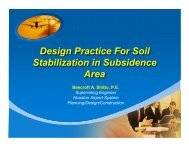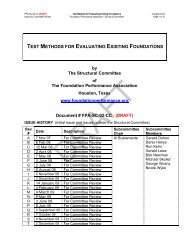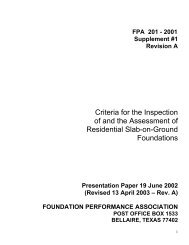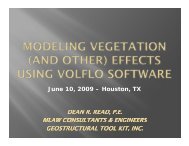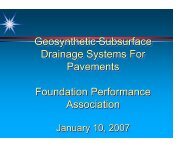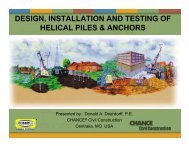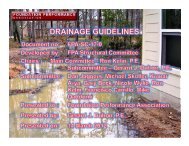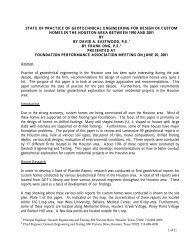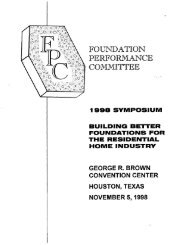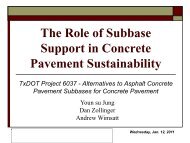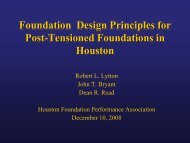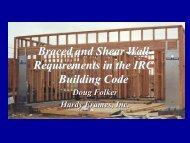Soil-Structure Interaction Seminar - Foundation Performance ...
Soil-Structure Interaction Seminar - Foundation Performance ...
Soil-Structure Interaction Seminar - Foundation Performance ...
You also want an ePaper? Increase the reach of your titles
YUMPU automatically turns print PDFs into web optimized ePapers that Google loves.
and rigidity to control, dissipate and distribute the actual loads.<br />
In this way, it should control movements in the upper structure<br />
such that a home does not have a significant number of reoccurring<br />
problems such as sticking doors, sheetrock cracks, brick cracks,<br />
etc. and it should not move in such a manner that the structure<br />
itself becomes unsafe.<br />
REQUIREMENTS:<br />
For a proper design to be successful several items must be<br />
'considered:<br />
A. Good soils information is important. A proper soil study<br />
and report, which include PTI design parameters,<br />
allowable soil bearing values, and plasticity indiGeS, is<br />
, recommended.<br />
B. _Proper lot preparation and building pad placement are<br />
necessary.<br />
C. Proper foundation makeup and reinforcement placement must<br />
be done.<br />
D. Good quality concrete and proper placement of the<br />
concrete are performance related items, which must be<br />
controlled.<br />
E. Correct curing procedures are important.<br />
F. Proper grading and drainage around the home are a must111<br />
G. Proper homeowner maintenance is also required.<br />
It has been our experience that good construction procedures<br />
and proper drainage have the largest overall effect on long term<br />
performance of residential foundations.<br />
AREAS FOR IMPROVEMENT<br />
Areas we see which consistently can use improvement are lot<br />
and pad preparation, curing procedures and homeowner maintenance.<br />
A. If a lot or pad is improperly placed, initial deflection<br />
and settlement can occur which can crack the foundation<br />
system, which is unreinforced for a minimum of 4 days<br />
after placement. Tendon stressing cannot be done until<br />
the concrete strength has increased sufficiently to<br />
accept the stressing forces. Once a crack has formed in<br />
the foundation, the slab will "in effect" hinge at that<br />
location and it is considerably less rigid than at the<br />
adjacent areas of the remaining foundation system. If<br />
the foundation is subjected to some amount of movement,<br />
problems in the upper structure can be concentrated in<br />
the vicinity of the crack.<br />
Page 3



